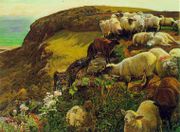 Yes, there is such a thing as English Art, although not too many people may be aware of it. Wikipedia actually defines English Art as “body of visual arts originating from the nation of England, in the form of a continuous tradition.” This kind of art was actually only defined in 1956 by Nikolaus Pevsner, in his book The Englishness of English Art. Many decades later, great men were still trying to give a clear definition to English Art. In 2000, Sir Roy Strong wrote The Spirit of Britain: A narrative history of the arts and in 2002, Peter Ackroyd wrote The Origins of the English Imagination.
Yes, there is such a thing as English Art, although not too many people may be aware of it. Wikipedia actually defines English Art as “body of visual arts originating from the nation of England, in the form of a continuous tradition.” This kind of art was actually only defined in 1956 by Nikolaus Pevsner, in his book The Englishness of English Art. Many decades later, great men were still trying to give a clear definition to English Art. In 2000, Sir Roy Strong wrote The Spirit of Britain: A narrative history of the arts and in 2002, Peter Ackroyd wrote The Origins of the English Imagination.
So what is English Art, really? The general consensus is that traditional English Art involves paintings of landscapes. English Art is not limited to this, however. Wikipedia further expounds on the themes of English Art:
Its earliest known developed form, one that continues to the present-day, is arguably the decorative surface pattern work exemplified by the Lindisfarne Gospels and the exterior carving of Anglo-Saxon churches and monuments. Ackroyd argues that the concern for a light and delicate outline, for surface pattern for its own sake, and for patterns and borders that threaten to overwhelm the portrayal of figures, have all been long-standing characteristics of a continuous English art. Other elements Ackroyd sees as inherited from the early Celtic church are a concern to portray the essence of animals, a tendency to understatement, and a concern for repeating structures that extends from Celtic knotwork to church organ music to Staffordshire ceramic-ware to stained glass windows and to the wallpapers of William Morris.
Indeed, a visit to England will prove to be a feast for the eyes and soul as one gazes upon various art forms, some of which have been around for millennia.